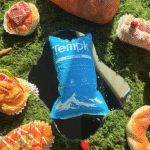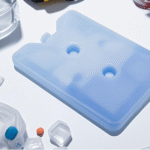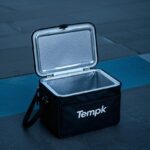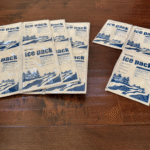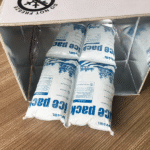Transporting insulin across cities, countries or just on a long weekend trip isn’t as simple as throwing it into a cooler. Insulin loses potency when it freezes or overheats, yet ordinary ice melts quickly and can leak. FDA approved dry ice sheets for insulin sound like the perfect solution, but the term is often misunderstood. In reality, dry ice is solid carbon dioxide at –78.5 °C (–109 °F), and contact with it can freeze insulin. This guide explains what “FDA approved” really means for dry ice packaging, when (and when not) to use dry ice sheets, and how to build a safe pack out to keep your insulin between 2 °C and 8 °C.

What does FDA approval mean for dry ice sheets? Learn about FDA regulations for packaging materials and why the CO₂ itself isn’t “approved”.
Are dry ice sheets safe for insulin? Understand why direct contact with –78 °C dry ice can damage insulin and how to buffer extreme cold.
How do you build a safe pack out? Step by step instructions for layering phase change materials (PCMs), insulation and dry ice.
How much dry ice should you use? Use formulas and sizing rules to calculate the right amount and avoid freezing.
What are the regulations? Know the 2.5 kg airline limit, labeling rules and packaging requirements.
What are the latest trends? Explore 2025 innovations in cold chain logistics, biodegradable packaging and IoT monitoring.
Are FDA Approved Dry Ice Sheets Safe for Insulin?
Direct answer: Dry ice sheets are not inherently “FDA approved,” and they are rarely safe for insulin by themselves. Dry ice sits at –78 °C and can freeze and denature insulin if it comes into direct contact. The FDA doesn’t actually approve the carbon dioxide ice; instead it regulates the packaging materials that may contact food or drugs. For insulin, which must stay between 2 °C and 8 °C to maintain potency, using dry ice requires a buffer layer such as phase change material (PCM) bricks set to +5 °C, otherwise the extreme cold will ruin the medicine.
Explanation: understanding “FDA approval” for dry ice sheets
When marketing describes “FDA approved dry ice sheets,” it usually refers to the packaging films, gels and adhesives that wrap or accompany the dry ice, not the CO₂ itself. The U.S. Food and Drug Administration (FDA) treats any substance intended to contact food or pharmaceuticals as a food contact material. Manufacturers must submit data through the Food Contact Notification (FCN) process showing that chemicals won’t migrate into foods at unsafe levels. For dry ice packs, compliance typically involves:
Outer films: High density polyethylene (HDPE) or polypropylene (PP) films that are inert and resist chemical migration. These plastics protect your insulin from contamination and are sturdy enough for cold conditions.
Refrigerant gels: Food grade super absorbent polymers that absorb water and freeze into a viscous mass. They must be non toxic and formulated to prevent chemical leaching when frozen and thawed.
Sealants and adhesives: Food safe hot melt adhesives create leak proof seals.
Labels: UN1845 hazard labels warn handlers that carbon dioxide (dry ice) is inside.
Therefore, an FDA compliant dry ice sheet for insulin must use food safe plastics and gels, but the CO₂ inside will still sit at –78 °C. Without proper buffering, insulin will freeze and crystallize.
Table 1: Components of an FDA compliant dry ice sheet and their benefits
| Component | Typical material | Food safety significance | Practical benefit for you |
| Outer film | HDPE, LDPE or PP | Inert plastics resist chemical migration and remain flexible at low temperatures | Keeps insulin containers free from chemical contamination and prevents film cracking |
| Refrigerant gel | Food grade superabsorbent polymer | Non toxic gel forms ice without leaching chemicals | Provides cooling without leaving messy water; reusable and safe |
| Sealants & adhesives | Food safe hot melt adhesives | Maintain leak proof seals | Prevents leaks during travel and protects other items in your kit |
| Labeling & marking | UN1845 hazardous material labels | Required for transport under DOT/IATA rules | Avoids fines, ensures airline compliance and informs carriers |
Practical tips and suggestions
Verify documentation: Always request an FDA compliance certificate from your supplier. Without proof, you risk using materials that may leach chemicals into your medicine.
Never let dry ice touch insulin: Even with FDA compliant packaging, you must separate insulin from dry ice. Use +5 °C PCM bricks or gel packs as a buffer.
Label clearly: Mark packages with “Contains Dry Ice” and the net weight of dry ice, as required by DOT/IATA.
Ask for insulation quality: When ordering, confirm that the outer film thickness matches your cold chain duration and ambient conditions.
Case example: A seafood company switched to polyethylene wrapped dry ice packs after learning that some generic packs used recycled plastics with unknown additives. By verifying FDA compliance and adding a cardboard barrier between the ice and their product, they eliminated customer complaints of off flavors.
How to Package Insulin with Dry Ice Sheets Properly
Keeping insulin cold without freezing is like balancing on a tightrope. Dry ice provides ultra cold temperatures for frozen vaccines but will freeze insulin without a protective buffer. The safe solution is to build a layered pack out using phase change materials, insulation and vented containers.
Step by step: Building a safe pack out
Pre condition your PCM: Place +5 °C PCM bricks or gel packs in the refrigerator for at least 24 hours to stabilize them at 2–8 °C. Do not put them in the freezer, as they could become too cold.
Prepare the insulin: Put insulin pens or vials in a rigid plastic or metal case to prevent crushing and provide structural support.
Layer with PCM: Wrap the insulin case with PCM bricks on all sides, leaving a 1–2 cm buffer between the insulin and any sub zero element. This creates a thermal “sandwich” that keeps temperatures in the safe 2–8 °C range.
Add insulation: Use high quality insulation like expanded polystyrene (EPS), expanded polypropylene (EPP) or vacuum insulated panels (VIPs) to slow heat transfer.
Place dry ice: Put dry ice sheets or blocks outside the PCM layer in the outer compartment of your cooler. Leave room for gas to escape and never seal the container airtight. Dry ice sublimates into CO₂ gas; a sealed container can explode.
Label and ventilate: Mark the container with “DRY ICE / CARBON DIOXIDE, SOLID” and the net weight, and ensure the lid has vents or holes for gas release.
Monitor the temperature: Place a temperature data logger near the insulin compartment. Set alarms at 2 °C and 8 °C with a delay (around 10 minutes) for handling events. Checking the log ensures your pack out stayed within range throughout the journey.
Actual case: A remote clinic sent insulin vials to a rural area by layering +5 °C PCM bricks inside a VIP lined container. They placed 0.8 kg of dry ice in the outer compartment and vented the box. The logger recorded temperatures between 3.5 °C and 6 °C over 48 hours, meeting regulatory requirements and preventing freeze damage.
Table 2: Pack out steps, recommended conditions and benefits
| Step | Action | Recommended condition | Benefit to you |
| 1 | Pre condition PCM bricks or gel packs | Refrigerate at 2–8 °C for ≥24 h | Stabilizes PCM at the correct temperature before packing |
| 2 | Place insulin in rigid case | Use hard plastic/metal container | Prevents physical damage and provides structure |
| 3 | Layer PCM around insulin | 4–6 sides with 1–2 cm buffer | Maintains 2–8 °C zone; prevents freezing |
| 4 | Insert insulation | EPS, EPP or VIP panels | Slows heat transfer, extends hold time |
| 5 | Position dry ice | Outside PCM layer; leave venting space | Provides extra cooling without contacting insulin |
| 6 | Label and ventilate container | Mark with “Dry Ice / Carbon Dioxide, Solid” and net weight | Complies with DOT/IATA; warns handlers |
| 7 | Monitor with data logger | Set alerts at 2 °C and 8 °C | Confirms temperature control and provides audit trail |
Practical tips for common scenarios
Short trip (≤18 hours, mild climate ≤25 °C): Skip dry ice. PCM bricks alone can maintain 2–8 °C. Two +5 °C PCM bricks in an insulated case are sufficient.
Moderate journey (25–32 °C, 18–36 hours): Add extra insulation and an extra PCM brick. Only use 0–0.5 kg/day of dry ice if ambient temperature is high.
Hot climate (≥32 °C) or multi day trip (>36 hours): Use a buffered dry ice pack out. Add four or more +5 °C PCM bricks and 0.5–0.8 kg of dry ice per day. Always keep dry ice outside the PCM layer to prevent freezing.
Ask yourself five questions: How long is your journey? What’s the peak temperature? How many pens or vials? Will you be without refrigeration? Do airline rules permit dry ice on your route? Answering these determines whether you need dry ice.
Pre weight and label: Airlines typically allow up to 2.5 kg (5.5 lb) of dry ice per passenger. Mark the net weight on the label and ensure ventilation.
Conduct a trial run: Perform a 12–24 hour test with a temperature logger before your actual trip to verify that your pack out maintains 2–8 °C.
Managing the amount of dry ice
Dry ice sublimates at about 5–10 pounds (2.27–4.54 kg) per 24 hours. To estimate how much you need, multiply your cooler’s volume by the temperature difference and factor in transit time. A simple formula used by logistics experts is:
(cooler volume × temperature gap × 0.12) ÷ 150 × 1.25
For example, a 100 L container traveling from 25 °C to –70 °C requires ~9.5 kg of dry ice. If your insulin trip is shorter and only requires 0 °C to +5 °C, you’ll need far less; a small cooler for a weekend trip may only use 0.5–1 kg of dry ice with proper PCM buffering. Remember that airlines limit each passenger to 2.5 kg, so adjust accordingly and consider splitting shipments or adding gel packs.
Regulatory and Safety Considerations
Shipping with dry ice involves more than just packing; you must comply with several regulations and safety guidelines.
Packaging requirements and venting
Gas venting: Packages containing dry ice must allow carbon dioxide gas to escape. Dry ice must never be sealed in an airtight container.
Package integrity: The package must be strong enough to withstand normal handling and prevent any loss of contents due to vibration, temperature or altitude changes.
Material selection: Avoid plastics that become brittle at low temperatures; use commercially available dry ice packaging intended for extreme cold.
Marking and labeling: Each package must be marked with “Carbon dioxide, solid” or “Dry Ice”, the shipper’s and recipient’s name and address, and the net quantity of dry ice. The outermost container must carry a hazard class 9 label and the UN number 1845.
Weight limits: The maximum allowable net quantity of dry ice in a package is 200 kg for commercial cargo, but airlines and the FAA limit passengers to 2.5 kg (5.5 lb) per package and per passenger. Always check with your carrier.
FAA and DOT rules for passenger travel
The Federal Aviation Administration (FAA) classifies dry ice as a hazardous material. Passengers may carry dry ice in baggage only with airline approval. The FAA requires that:
The package must not be airtight and must allow CO₂ to vent.
The package must be labeled “Dry ice” or “Carbon dioxide, solid” and show the net weight of dry ice or state that it’s 2.5 kg or less.
Pharmaceutical packaging regulations
Under 21 CFR 211.94(b), container closure systems for pharmaceuticals must protect against foreseeable external factors that can cause deterioration or contamination. For insulin shipments, triple packaging is often required: a primary container (vial or pen), a secondary packaging (rigid case), and an outer insulated package with dry ice. The Parenteral Drug Association (PDA) and ASTM also publish standards for thermal packaging tests.
Safety tips for handling dry ice
Wear protective gear: Dry ice can cause frostbite. Wear insulated gloves, goggles and a bib when handling.
Avoid airtight storage: Never store dry ice in glass or sealed containers; sublimation can cause pressure build up and explosion.
Separate contents: Keep insulin or other products separate from dry ice; its only purpose is to keep the system cold.
Calculate sublimation rate: Expect 5–10 lb of dry ice to sublimate every 24 hours and factor in an extra day for delays.
Supplement with gel packs: Combining dry ice with frozen gel packs can reduce the amount of dry ice needed and mitigate extreme cold.
Alternatives to Dry Ice Sheets for Insulin
Dry ice isn’t always the best or safest choice for insulin. Alternatives like gel packs and phase change materials often keep insulin within the safe range without complicated regulations.
Gel packs and PCM bricks
Gel packs are pouches filled with non toxic, food grade gels that freeze at around 0–4 °C and remain flexible. Medical grade gel packs can maintain refrigerated temperatures up to 33 hours and room temperature hold times over 52 hours. Phase change material (PCM) bricks engineered to melt at +5 °C provide precise temperature control for 24–48 hours and can be reused thousands of times. Both options avoid the need for vented packaging and hazardous material labeling.
Hydrogel evaporative packs use crystals that absorb water and slowly evaporate, keeping contents around +20 °C for 45 hours. They are lightweight and convenient for outdoor travel or room temperature insulin but cannot maintain refrigerated conditions.
Advantages of gel packs and PCMs (at a glance)
| Solution | Cooling range | Typical hold time | Reusability & sustainability | User benefits |
| Medical grade gel pack | 0–4 °C | Up to 33 hours refrigerated; 52 hours at room temperature | Reusable, non toxic, leak proof | Safe for airline carry on; prevents freezing; flexible and durable |
| +5 °C PCM brick | +2 °C to +8 °C | 24–48 hours depending on insulation | Highly reusable; eco friendly | Precise temperature control; regulatory compliance; reduces waste |
| Hydrogel evaporative pack | ~+20 °C | 45 hours or more | Reusable after rehydration | Ideal for room temperature insulin; lightweight; TSA approved |
Tips for using alternatives
Opt for PCMs for long trips: PCM bricks preconditioned to +5 °C offer tight control and are safe for insulin. They’re easy to reuse and avoid hazardous classification.
Combine gel packs with insulation: For short flights, one gel pack may suffice, but adding an insulated sleeve or reflective foil can double the hold time.
Hydrate evaporative packs properly: Soak hydrogel packs in clean water for the recommended time, then blot off excess moisture before placing them in your travel kit.
Store and reuse gel packs correctly: Refreeze gel packs flat for 24 hours before each trip; inspect for leaks; rotate packs and mark the date and number of uses.
2025 Trends and Innovations in Cold Chain Logistics
The cold chain industry is evolving rapidly. Supply constraints, sustainability pressures and new technologies are reshaping how companies transport temperature sensitive products.
Market dynamics
The global dry ice market is growing despite headwinds. Demand has been climbing around 5 % per year, while CO₂ supply grows only 0.5 %, leading to periodic shortages and price volatility. Spot prices have surged by up to 300 % during supply crunches. Even so, the market was valued at USD 1.54 billion in 2024 and is projected to reach USD 2.73 billion by 2032 (compound annual growth rate ~7.4 %). Growth is fueled by rising demand for biologics, mRNA vaccines and frozen food delivery.
Dry ice formats and performance
Not all dry ice is equal. Large blocks or slabs sublimate slowly and are ideal for bulk shipments or long durations. Pellets and nuggets, with more surface area, provide rapid cooling but vaporize faster, making them suitable for pre chilling or short hauls. Thin slices or custom cuts balance coverage and duration, fitting neatly into packaging systems to reduce voids. Choosing the wrong format can compromise product integrity—small pellets may supercool pharma payloads if not properly vented, while large blocks may be too slow for fast e commerce shipments.
Packaging and insulation innovations
Thermal performance depends as much on container design as on the ice itself. Poorly designed containers accelerate sublimation; optimized insulation can stretch hold times significantly. Key factors include pre conditioning containers before loading, minimizing void space, and arranging the dry ice above the payload so cold air sinks. In 2025, innovations include:
Biodegradable films: Manufacturers are experimenting with polylactic acid (PLA) and cellulose films that can be FDA compliant. These reduce plastic waste but may have shorter shelf lives.
Smart sensors: Real time data loggers with Bluetooth or cellular connectivity alert shippers to temperature excursions. Over 70 % of shippers now require real time monitoring for pharmaceuticals.
Hybrid systems: Combining dry ice with reusable PCMs reduces the required amount of dry ice and limits supercooling. Pharma & biotech companies are validating packaging against both undercooling and supercooling, incorporating monitoring and barrier technologies.
Distributed production: To avoid supply shortages, manufacturers are building local CO₂ production hubs and diversifying suppliers.
Key takeaways for travelers and small shippers
Match the format to your needs: Use thin dry ice sheets or pellets for small, well insulated containers and blocks for longer journeys.
Invest in high performance insulation: Vacuum insulated panels and EPS with high density slow sublimation and extend hold time.
Balance dry ice with PCMs: Many pharma companies now use hybrid solutions that combine dry ice with PCM bricks to mitigate extreme cold.
Plan for volatility: Supply shortages and price swings may affect availability. Consider reusable PCM and gel packs as back ups.
Frequently Asked Questions (FAQ)
Q1: Can I bring a dry ice sheet on an airplane for my insulin?
Yes, but there are strict rules. Airlines and the FAA limit dry ice to 2.5 kg (5.5 lb) per passenger or package. The package must vent CO₂ gas and be marked “Dry ice” or “Carbon dioxide, solid” with the net weight. Always check with your airline and ensure your container is vented and labeled. Consider using gel or PCM packs when possible to avoid extra paperwork.
Q2: What’s the ideal temperature range for insulin during travel?
Insulin should be kept between 36 °F and 46 °F (2 °C–8 °C) according to FDA guidelines. Unopened insulin stored in this range remains potent until its expiration date. Once opened, it can be kept at room temperature (59 °F–86 °F) for up to 28 days, but it should never freeze. If insulin is exposed to extreme temperatures or freezes, discard it and use a new vial or pen.
Q3: How much dry ice should I use for a 48 hour insulin shipment?
A common rule is 5–10 lb of dry ice per 24 hours. For a 48 hour shipment in hot conditions, you might need 0.5–0.8 kg of dry ice per day alongside multiple +5 °C PCM bricks. Always ensure dry ice stays outside the PCM layer and that the container is vented.
Q4: What’s the difference between dry ice sheets, gel packs and PCM bricks?
Dry ice sheets contain solid CO₂ at –78 °C and offer intense cold for frozen goods but can freeze insulin. Gel packs freeze around 0 °C and provide cooling for 12–36 hours; they’re reusable and don’t require hazardous labeling. PCM bricks designed for +5 °C maintain insulin safely within 2–8 °C for 24–48 hours and are the best choice for most insulin travel.
Q5: How do I check if a dry ice sheet is truly FDA compliant?
The FDA does not approve dry ice itself. Instead, check that the packaging materials (film, gel and sealants) are listed in the FDA’s food contact substance inventory. Ask your supplier for Food Contact Notification (FCN) documentation and verify that the outer film is HDPE/PP and the gel is food grade polymer. Also confirm that the product comes with proper UN1845 labeling and hazard class 9 markings.
Q6: Are there eco friendly options for dry ice sheets?
Yes. In 2025, some manufacturers use biodegradable polymers like polylactic acid (PLA) or cellulose for outer films. These materials can be FDA compliant but may have shorter shelf lives. You can also reduce dry ice use by opting for hybrid systems that combine smaller amounts of dry ice with reusable PCM bricks, cutting CO₂ usage and waste.
Summary & Recommendations
Key takeaways:
Dry ice itself is not FDA approved—only the packaging materials are regulated, and CO₂ always sits at –78 °C.
Insulin must stay between 2 °C and 8 °C; direct contact with dry ice will freeze and denature it.
To use dry ice sheets safely, build a layered pack out: pre condition +5 °C PCM bricks, wrap insulin in PCM, add insulation, then place dry ice outside the PCM layer.
Label, vent and follow regulations: Mark packages “Dry Ice/Carbon Dioxide, Solid”, include net weight, vent the container and respect the 2.5 kg airline limit.
Consider gel packs or PCM bricks as safer alternatives; they avoid hazardous labeling and maintain 2–8 °C without freezing.
Actionable recommendations:
Choose the right coolant: For trips under 24 hours or moderate climates, use +5 °C PCM bricks or gel packs. Reserve dry ice for long journeys in high heat and always buffer it with PCM.
Check compliance: Verify that any dry ice sheet or pack uses FDA compliant films and gels. Ask for documentation and ensure UN1845 hazard labels.
Prepare properly: Pre condition PCMs, layer them around insulin, ventilate the container and add a temperature logger. Perform a trial run to confirm the system before real travel.
Stay informed: Keep up with 2025 innovations such as biodegradable materials and smart sensors. These can reduce waste and give you real time assurance during transit.
Contact experts: For complex shipments or high value pharmaceuticals, consult a cold chain specialist like Tempk to design a validated packaging solution tailored to your route and ambient conditions.
About TemPK
TemPK is an innovative cold chain technology company specializing in insulated packaging, ice packs and phase change materials for food and pharmaceuticals. We develop reusable dry ice packs, +5 °C PCM bricks and vacuum insulated boxes designed to maintain stringent temperature ranges. Our R&D center focuses on sustainable materials and smart temperature monitoring. We hold international quality certifications and operate eco friendly production facilities. By combining science based design and field tested solutions, we help customers ship temperature sensitive goods safely and sustainably.
Call to action: Need help designing a compliant pack out for insulin or other medicines? Contact TemPK’s cold chain experts to get a customized solution. We can assess your route, calculate the right combination of PCM and dry ice, and provide validated packaging to ensure your medicines arrive safely.
















